Overview
- Brief Narrative
- Postage stamp issued by the General Gouvernement, the civilian ruling authority established by the Germans in southwestern Poland in 1939. This area was ceded to Germany under the terms of the German-Soviet Pact and it would be occupied by the Germans until 1944. It was divided into four administrative districts with seats in Krakow, Warsaw, Radom, and Lublin. There were several issues of stamps featuring historic landmarks of the region that the Germans claimed were of ancient German origin. This stamp depicts Wawel Castle in Krakow.
- Date
-
issue:
1941-1941
- Geography
-
issue:
Poland
- Credit Line
- United States Holocaust Memorial Museum Collection, Gift of Terry Friedman
- Markings
- front, bottom, white text on black background : GENERALGOUVERNEMENT
Physical Details
- Classification
-
Exchange Media
- Category
-
Postage stamps
- Object Type
-
Occupation stamps (lcsh)
- Physical Description
- Rectangular paper stamp with perforated edges; on the recto is a graphic design in red ink. It features an illustration of a walled castle with 2 large towers, one in the foreground, one in the background, and third in the far background. In the top left corner is a dexter eagle with outstretched wings, perched atop a pedestal holding a swastika in its talons. The denomination 24 is printed in large type in the lower right corner. German text is printed along the lower border. A faded partial circular cancellation stamp in black ink can be seen n the upper right. The verso is covered with aged yellowed adhesive.
- Dimensions
- overall: Height: 1.250 inches (3.175 cm) | Width: 1.000 inches (2.54 cm)
- Materials
- overall : paper, ink, adhesive
Rights & Restrictions
- Conditions on Access
- No restrictions on access
- Conditions on Use
- No restrictions on use
Keywords & Subjects
Administrative Notes
- Legal Status
- Permanent Collection
- Provenance
- The postage stamp was donated to the United States Holocaust Memorial Museum in 2005 by Terry Friedman.
- Record last modified:
- 2024-01-05 14:36:58
- This page:
- https://collections.ushmm.org/search/catalog/irn45777
Download & Licensing
In-Person Research
- By Appointment
- Request 21 Days in Advance of Visit
- Plan a Research Visit
- Request to See This Object
Contact Us
Also in Terry Friedman collection
The collection consists of a selection of postage stamps issued by the fascist governments of Germany and Italy from 1938-1941.
Date: 1938-1941
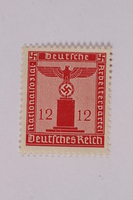
Postage stamp, 12 pfennig, from the Official Series of 1938 issued by Nazi Germany
Object
Postage stamp issued by the German government in 1938 for use by members of the National Socialist Party to send official mail. This is one from a series of 11 stamps, with the following denominations: 1, 3, 4, 5, 6, 8, 12, 16, 24, 30, 40. It features the Nazi Government emblem, the Reichsadler [Imperial Eagle], looking to the right with outstretched wings, perched atop a pedestal holding a swastika in its talons.
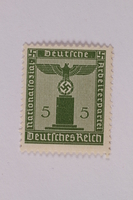
Postage stamp, 5 pfennig, from the Official Series of 1938 issued by Nazi Germany
Object
Postage stamp issued by the German government in 1938 for use by members of the National Socialist Party to send official mail. This is one from a series of 11 stamps, with the following denominations: 1, 3, 4, 5, 6, 8, 12, 16, 24, 30, 40. It features the Nazi Government emblem, the Reichsadler [Imperial Eagle], looking to the right with outstretched wings, perched atop a pedestal holding a swastika in its talons.
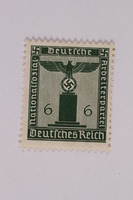
Postage stamp, 6 pfennig, from the Official Series of 1938 issued by Nazi Germany
Object
Postage stamp issued by the German government in 1938 for use by members of the National Socialist Party to send official mail. This is one from a series of 11 stamps, with the following denominations: 1, 3, 4, 5, 6, 8, 12, 16, 24, 30, 40. It features the Nazi Government emblem, the Reichsadler [Imperial Eagle], looking to the right with outstretched wings, perched atop a pedestal holding a swastika in its talons.
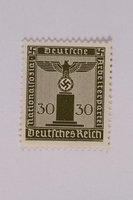
Postage stamp, 30 pfennig, from the Official Series of 1938 issued by Nazi Germany
Object
Postage stamp issued by the German government in 1938 for use by members of the National Socialist Party to send official mail. This is one from a series of 11 stamps, with the following denominations: 1, 3, 4, 5, 6, 8, 12, 16, 24, 30, 40. It features the Nazi Government emblem, the Reichsadler [Imperial Eagle], looking to the right with outstretched wings, perched atop a pedestal holding a swastika in its talons.
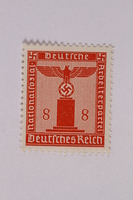
Postage stamp, 8 pfennig, from the Official Series of 1938 issued by Nazi Germany
Object
Postage stamp issued by the German government in 1938 for use by members of the National Socialist Party to send official mail. This is one from a series of 11 stamps, with the following denominations: 1, 3, 4, 5, 6, 8, 12, 16, 24, 30, 40. It features the Nazi Government emblem, the Reichsadler [Imperial Eagle], looking to the right with outstretched wings, perched atop a pedestal holding a swastika in its talons.
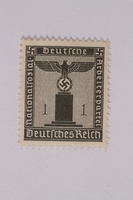
Postage stamp, 1 pfennig, from the Official Series of 1938 issued by Nazi Germany
Object
Postage stamp issued by the German government in 1938 for use by members of the National Socialist Party to send official mail. This is one from a series of 11 stamps, with the following denominations: 1, 3, 4, 5, 6, 8, 12, 16, 24, 30, 40. It features the Nazi Government emblem, the Reichsadler [Imperial Eagle], looking to the right with outstretched wings, perched atop a pedestal holding a swastika in its talons.
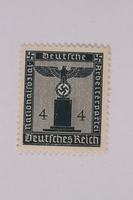
Postage stamp, 4 pfennig, from the Official Series of 1938 issued by Nazi Germany
Object
Postage stamp issued by the German government in 1938 for use by members of the National Socialist Party to send official mail. This is one from a series of 11 stamps, with the following denominations: 1, 3, 4, 5, 6, 8, 12, 16, 24, 30, 40. It features the Nazi Government emblem, the Reichsadler [Imperial Eagle], looking to the right with outstretched wings, perched atop a pedestal holding a swastika in its talons.
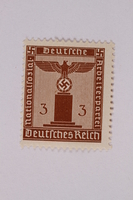
Postage stamp, 3 pfennig, from the Official Series of 1938 issued by Nazi Germany
Object
Postage stamp issued by the German government in 1938 for use by members of the National Socialist Party to send official mail. This is one from a series of 11 stamps, with the following denominations: 1, 3, 4, 5, 6, 8, 12, 16, 24, 30, 40. It features the Nazi Government emblem, the Reichsadler [Imperial Eagle], looking to the right with outstretched wings, perched atop a pedestal holding a swastika in its talons.
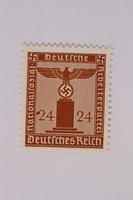
Postage stamp, 24 pfennig, from the Official Series of 1938 issued by Nazi Germany
Object
Postage stamp issued by the German government in 1938 for use by members of the National Socialist Party to send official mail. This is one from a series of 11 stamps, with the following denominations: 1, 3, 4, 5, 6, 8, 12, 16, 24, 30, 40. It features the Nazi Government emblem, the Reichsadler [Imperial Eagle], looking to the right with outstretched wings, perched atop a pedestal holding a swastika in its talons.
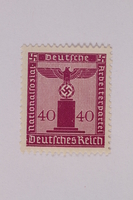
Postage stamp, 40 pfennig, from the Official Series of 1938 issued by Nazi Germany
Object
Postage stamp issued by the German government in 1938 for use by members of the National Socialist Party to send official mail. This is one from a series of 11 stamps, with the following denominations: 1, 3, 4, 5, 6, 8, 12, 16, 24, 30, 40. It features the Nazi Government emblem, the Reichsadler [Imperial Eagle], looking to the right with outstretched wings, perched atop a pedestal holding a swastika in its talons.
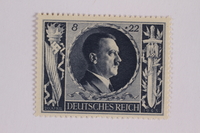
Postage stamp, 8 Reichsmarks +22 schillings, issued for the birthday of Adolf Hitler
Object
Postage stamp issued by the German government to commemorate the 54th birthday of Adolf Hitler on April 20, 1943. It was issued in a series of 6. Designed by Gottfreid Klein, it features a realistic portrait of Hitler in right profile, with a quill, torch, and sword in the borders.
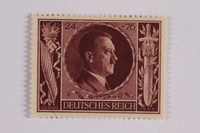
Postage stamp, 24 Reichsmarks +76 schillings, issued for the birthday of Adolf Hitler
Object
Postage stamp issued by the German government to commemorate the 54th birthday of Adolf Hitler on April 20, 1943. It was issued in a series of 6. Designed by Gottfreid Klein, it features a realistic portrait of Hitler in right profile, with a quill, torch, and sword in the borders.
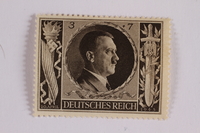
Postage stamp, 3 Reichsmarks +7 schillings, issued for the birthday of Adolf Hitler
Object
Postage stamp issued by the German government to commemorate the 54th birthday of Adolf Hitler on April 20, 1943. It was issued in a series of 6. Designed by Gottfreid Klein, it features a realistic portrait of Hitler in right profile, with a quill, torch, and sword in the borders.
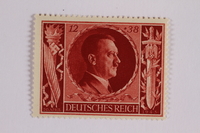
Postage stamp, 12 Reichsmarks +38 schillings, issued for the birthday of Adolf Hitler
Object
Postage stamp issued by the German government to commemorate the 54th birthday of Adolf Hitler on April 20, 1943. It was issued in a series of 6. Designed by Gottfreid Klein, it features a realistic portrait of Hitler in right profile, with a quill, torch, and sword in the borders.
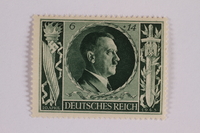
Postage stamp, 6 Reichsmarks +14 schillings, issued for the birthday of Adolf Hitler
Object
Postage stamp issued by the German government to commemorate the 54th birthday of Adolf Hitler on April 20, 1943. It was issued in a series of 6. Designed by Gottfreid Klein, it features a realistic portrait of Hitler in right profile, with a quill, torch, and sword in the borders.
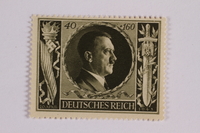
Postage stamp, 40 Reichsmarks +160 schillings, issued for the birthday of Adolf Hitler
Object
Postage stamp issued by the German government to commemorate the 54th birthday of Adolf Hitler on April 20, 1943. It was issued in a series of 6. Designed by Gottfreid Klein, it features a realistic portrait of Hitler in right profile, with a quill, torch, and sword in the borders.
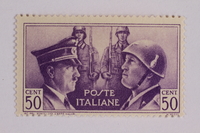
Postage stamp, 50 centimes, issued by Italy to honor German-Italian friendship
Object
Postage stamp issued by the Fascist government of Italy to honor the alliance between Germany and Italy. It features Hitler in cap and Mussolini in helmet, facing each other in profile, with a German and an Italian soldier in the background.
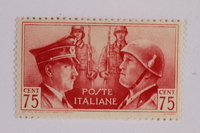
Postage stamp, 75 centimes, issued by Italy to honor German-Italian friendship
Object
Postage stamp issued by the Fascist government of Italy to honor the alliance between Germany and Italy. It features Hitler in a military cap and Mussolini in a helmet, facing each other in profile, with a German and an Italian soldier in the background.
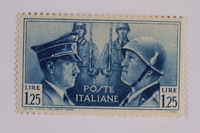
Postage stamp, 1.25 lira, issued by Italy to honor German-Italian friendship
Object
Postage stamp issued by the Fascist government of Italy to honor the alliance between Germany and Italy. It features Hitler in cap and Mussolini in helmet, facing each other in profile, with a German and an Italian soldier in the background.
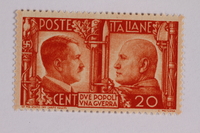
Postage stamp, 20 centimes, issued by Italy to honor the German-Italian wartime alliance
Object
Postage stamp issued by the Fascist government of Italy to celebrate the alliance between Germany and Italy. It depicts Hitler and Mussolini, facing each other in profile, with a German and an Italian soldier in the background. It features the slogan: DUE POPOLI / UNA GUERRA [TWO PEOPLES / ONE WAR].
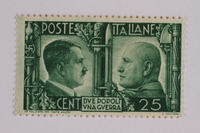
Postage stamp, 25 centimes, issued by Italy to honor the German-Italian wartime alliance
Object
Postage stamp issued by the Fascist government of Italy to celebrate the alliance between Germany and Italy. It depicts Hitler and Mussolini, facing each other in profile, with a German and an Italian soldier in the background. It features the slogan: DUE POPOLI / UNA GUERRA [TWO PEOPLES / ONE WAR].
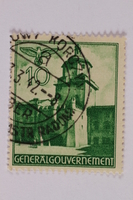
Postage stamp, 10 zloty, featuring the Krakow gate, Lublin, issued in German occupied Poland
Object
Postage stamp issued by the General Gouvernement, the civilian ruling authority established by the Germans in southwestern Poland in 1939. This area was ceded to Germany under the terms of the German-Soviet Pact and it would be occupied by the Germans until 1944. It was divided into four administrative districts with seats in Krakow, Warsaw, Radom, and Lublin. There were several issues of stamps featuring historic landmarks of the region that the Germans claimed were of ancient German origin. This stamp depicts the Krakow Gate in Lublin.
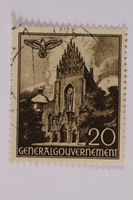
Postage stamp, 20 zloty, featuring the Dominican Church, Krakow, issued in German occupied Poland
Object
Postage stamp issued by the General Gouvernement, the civilian ruling authority established by the Germans in southwestern Poland in 1939. This area was ceded to Germany under the terms of the German-Soviet Pact and it would be occupied by the Germans until 1944. It was divided into four administrative districts with seats in Krakow, Warsaw, Radom, and Lublin. There were several issues of stamps featuring historic landmarks of the region that the Germans claimed were of ancient German origin. This stamp depicts the Dominican Church in Krakow.
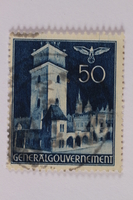
Postage stamp, 50 zloty, featuring the Town Hall Tower, Krakow, issued in German occupied Poland
Object
Postage stamp issued by the General Gouvernement, the civilian ruling authority established by the Germans in southwestern Poland in 1939. This area was ceded to Germany under the terms of the German-Soviet Pact and it would be occupied by the Germans until 1944. It was divided into four administrative districts with seats in Krakow, Warsaw, Radom, and Lublin. There were several issues of stamps featuring historic landmarks of the region that the Germans claimed were of ancient German origin. This stamp depicts the Town Hall Tower in Krakow.
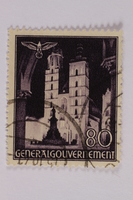
Postage stamp, 80 zloty, featuring Saint Mary's Basilica, Krakow, issued in German occupied Poland
Object
Postage stamp issued by the General Gouvernement, the civilian ruling authority established by the Germans in southwestern Poland in 1939. This area was ceded to Germany under the terms of the German-Soviet Pact and it would be occupied by the Germans until 1944. It was divided into four administrative districts with seats in Krakow, Warsaw, Radom, and Lublin. There were several issues of stamps featuring historic landmarks of the region that the Germans claimed were of ancient German origin. This stamp depicts Saint Mary's Basilica in Krakow.
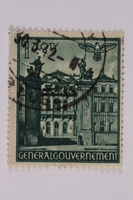
Postage stamp, 1 zloty, featuring Bruhlsche Palace, Warsaw, issued in German occupied Poland
Object
Postage stamp issued by the General Gouvernement, the civilian ruling authority established by the Germans in southwestern Poland in 1939. This area was ceded to Germany under the terms of the German-Soviet Pact and it would be occupied by the Germans until 1944. It was divided into four administrative districts with seats in Krakow, Warsaw, Radom, and Lublin. There were several issues of stamps featuring historic landmarks of the region that the Germans claimed were of ancient German origin. This stamp depicts Bruhlsche Palace in Warsaw.
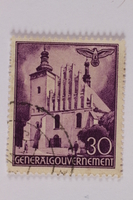
Postage stamp, 30 zloty, featuring St. Brigit's Church, Lublin, issued in German occupied Poland
Object
Postage stamp issued by the General Gouvernement, the civilian ruling authority established by the Germans in southwestern Poland in 1939. This area was ceded to Germany under the terms of the German-Soviet Pact and it would be occupied by the Germans until 1944. It was divided into four administrative districts with seats in Krakow, Warsaw, Radom, and Lublin. There were several issues of stamps featuring historic landmarks of the region that the Germans claimed were of ancient German origin. This stamp depicts St. Brigit's Church, Lublin.
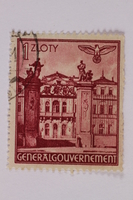
Postage stamp, 1 zloty, featuring Bruhlsche Palace, Warsaw, issued in German occupied Poland
Object
Postage stamp issued by the General Gouvernement, the civilian ruling authority established by the Germans in southwestern Poland in 1939. This area was ceded to Germany under the terms of the German-Soviet Pact and it would be occupied by the Germans until 1944. It was divided into four administrative districts with seats in Krakow, Warsaw, Radom, and Lublin. There were several issues of stamps featuring historic landmarks of the region that the Germans claimed were of ancient German origin. This stamp depicts Bruhschle Palace, Warsaw.
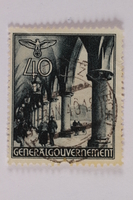
Postage stamp, 40 zloty, featuring the Cloth Hall, Krakow, issued in German occupied Poland
Object
Postage stamp issued by the General Gouvernement, the civilian ruling authority established by the Germans in southwestern Poland in 1939. This area was ceded to Germany under the terms of the German-Soviet Pact and it would be occupied by the Germans until 1944. It was divided into four administrative districts with seats in Krakow, Warsaw, Radom, and Lublin. There were several issues of stamps featuring historic landmarks of the region that the Germans claimed were of ancient German origin. This stamp depicts the Cloth Hall in Warsaw.
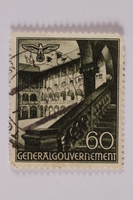
Postage stamp, 60 zloty, featuring Castle Court, Krakow, issued in German occupied Poland
Object
Postage stamp issued by the General Gouvernement, the civilian ruling authority established by the Germans in southwestern Poland in 1939. This area was ceded to Germany under the terms of the German-Soviet Pact and it would be occupied by the Germans until 1944. It was divided into four administrative districts with seats in Krakow, Warsaw, Radom, and Lublin. There were several issues of stamps featuring historic landmarks of the region that the Germans claimed were of ancient German origin. This stamp depicts Castle Court in Krakow.
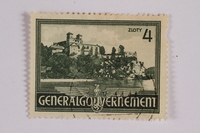
Postage stamp, 4 zloty, featuring Tyniec Monastery, issued in German occupied Poland
Object
Postage stamp issued by the General Gouvernement, the civilian ruling authority established by the Germans in southwestern Poland in 1939. This area was ceded to Germany under the terms of the German-Soviet Pact and it would be occupied by the Germans until 1944. It was divided into four administrative districts with seats in Krakow, Warsaw, Radom, and Lublin. There were several issues of stamps featuring historic landmarks of the region that the Germans claimed were of ancient German origin. This stamp depicts Tyniec Monastery.
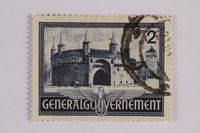
Postage stamp, 2 zloty, featuring the Barbican, Krakow, issued in German occupied Poland
Object
Postage stamp issued by the General Gouvernement, the civilian ruling authority established by the Germans in southwestern Poland in 1939. This area was ceded to Germany under the terms of the German-Soviet Pact and it would be occupied by the Germans until 1944. It was divided into four administrative districts with seats in Krakow, Warsaw, Radom, and Lublin. There were several issues of stamps featuring historic landmarks of the region that the Germans claimed were of ancient German origin. This stamp depicts the Barbican, Krakow.



